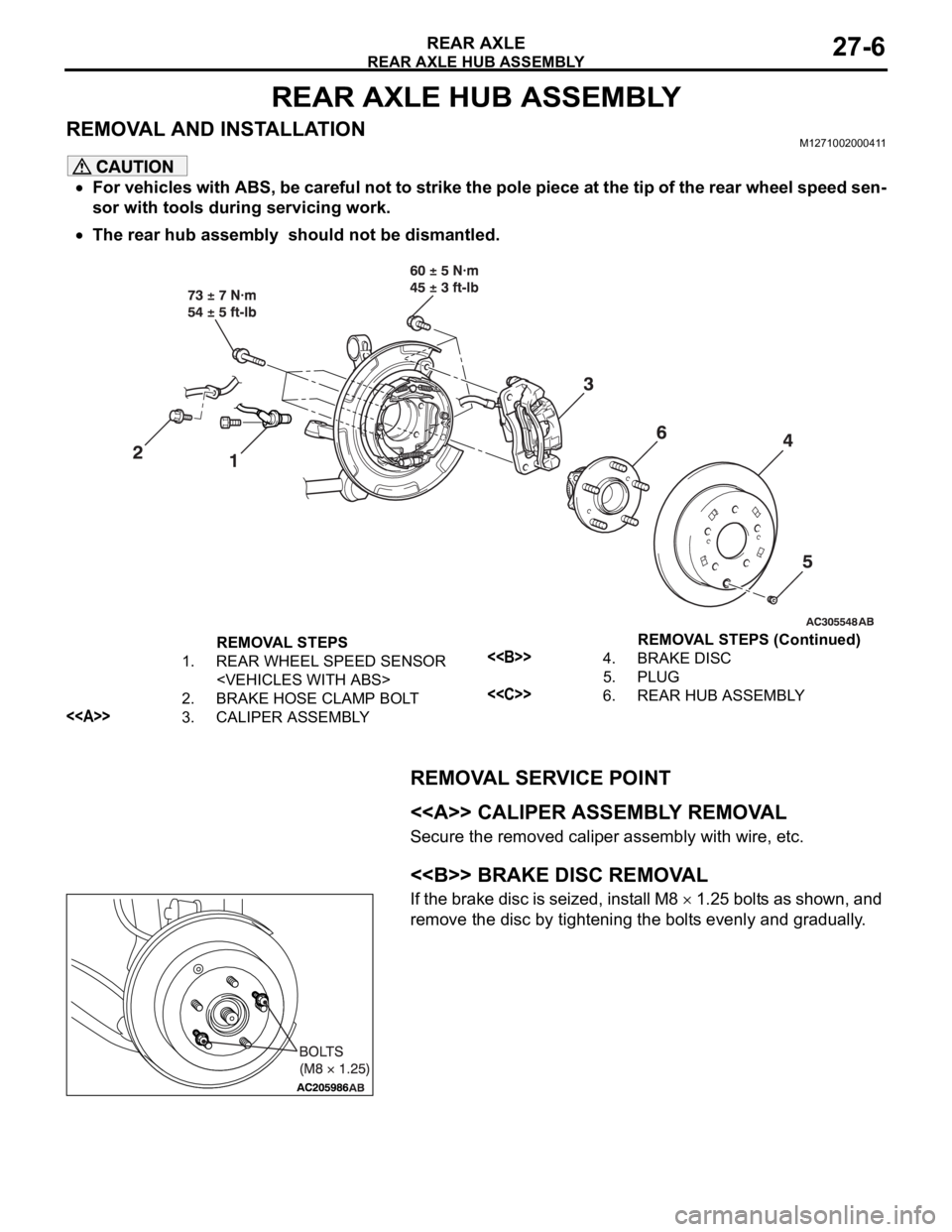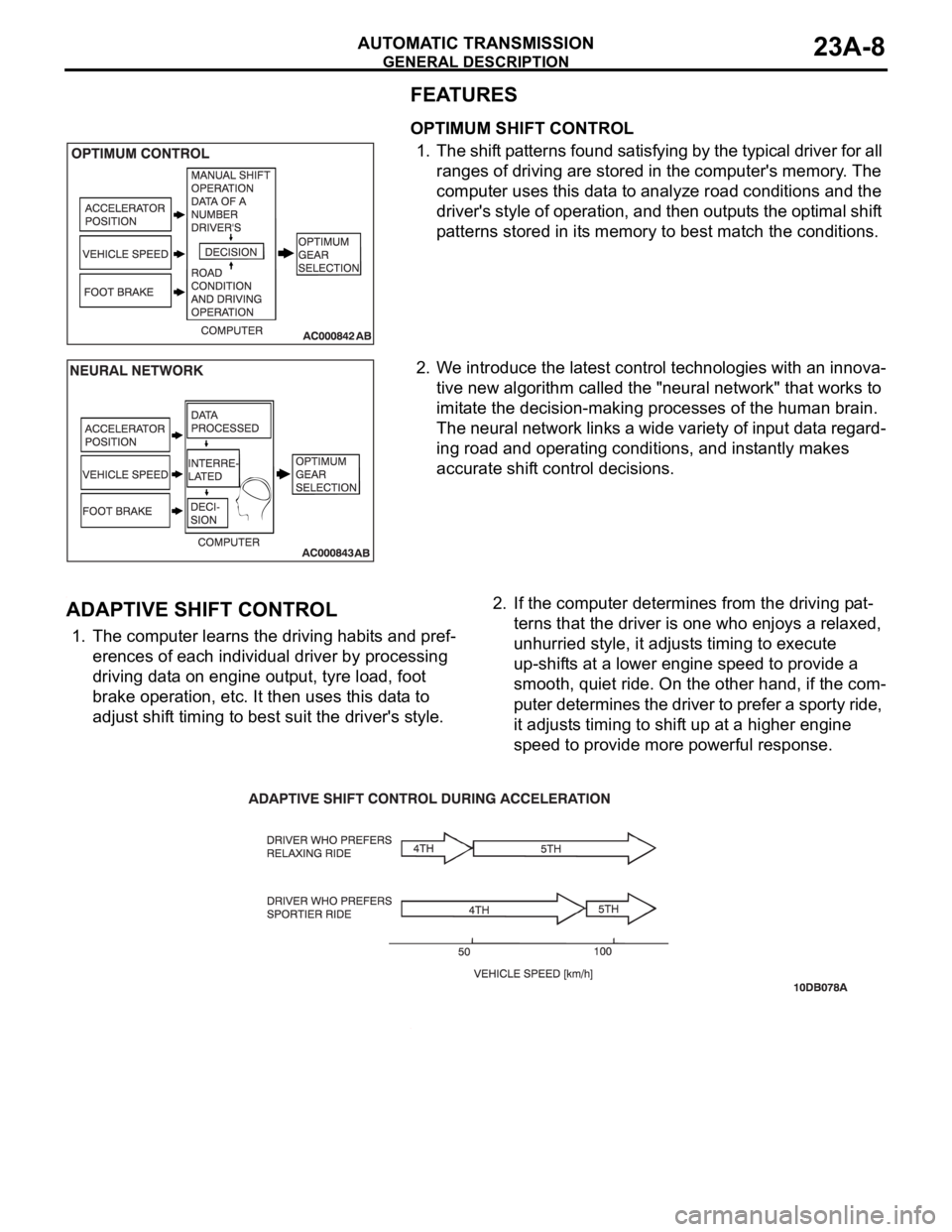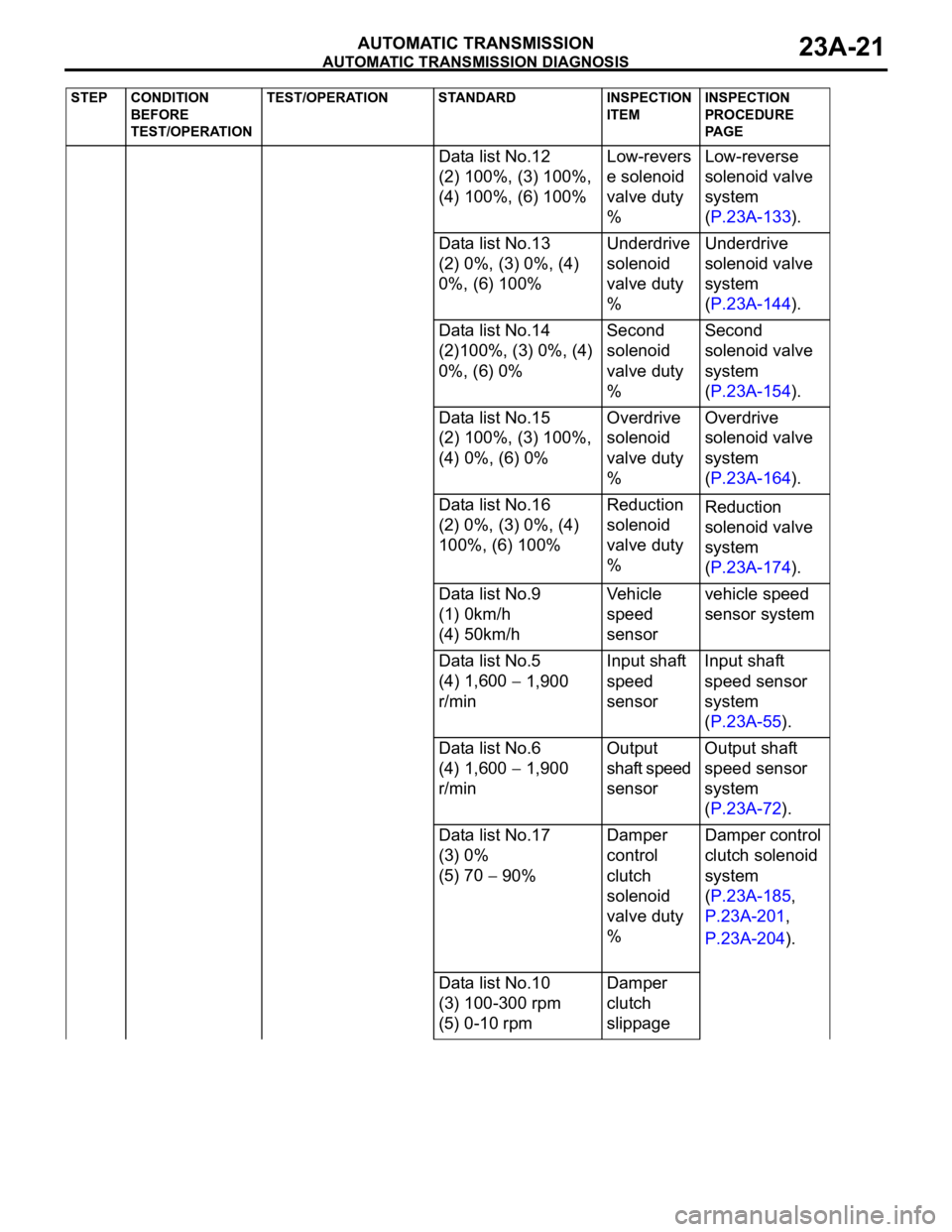2005 MITSUBISHI 380 SPEED
[x] Cancel search: SPEEDPage 1453 of 1500

REAR AXLE HUB ASSEMBLY
REAR AXLE27-6
REAR AXLE HUB ASSEMBLY
REMOVAL AND INSTALLATIONM1271002000411
For vehicles with ABS, be careful not to strike the pole piece at the tip of the rear wheel speed sen-
sor with tools during servicing work.
The rear hub assembly should not be dismantled.
REMOVAL SERVICE POINT
.
<> CALIPER ASSEMBLY REMOVAL
Secure the removed caliper assembly with wire, etc.
.
<> BRAKE DISC REMOVAL
If the brake disc is seized, install M8 1.25 bolts as shown, and
remove the disc by tightening the bolts evenly and gradually.
.
REMOVAL STEPS
1. REAR WHEEL SPEED SENSOR
2. BRAKE HOSE CLAMP BOLT
<>3. CALIPER ASSEMBLY
<>4. BRAKE DISC
5. PLUG
<
Page 1462 of 1500

GENERAL DESCRIPTION
AUTOMATIC TRANSMISSION23A-3
GENERAL DESCRIPTIONM1231000100366
ITEM SPECIFICATION
Transmission modelF5A5A-4-C5Z
Engine model 6G75-S4-MP
Torque converter Type 3-element, 1-stage, 2-phase type
Lock-up Provided
Stall torque ratio 1.71
Transmission type5 forward speeds, 1 reverse speed, fully automatic
Transmission gear
ratio1st 3.789
2nd 2.162
3rd 1.421
4th 1.000
5th 0.686
Reverse 3.117
Final reduction ratio (Differential gear ratio) 3.325
Clutch Multi-disc type 4 sets
Brake Multi-disc type 2 sets, band type 1 set
Manual control system P-R-N-D (4 position) + Sport mode (up, down)
Shift pattern control Electronic control
Hydraulic control during shifting Electronic control (Each clutch hydraulically independently
controlled)
Torque converter clutch control Electronic control
Transmission fluid Specified lubricants MITSUBISHI ELC4-SP III
Quantity (litres) 8.4
Page 1467 of 1500

GENERAL DESCRIPTION
AUTOMATIC TRANSMISSION23A-8
FEATURES
OPTIMUM SHIFT CONTROL
1. The shift patterns found satisfying by the typical driver for all
ranges of driving are stored in the computer's memory. The
computer uses this data to analyze road conditions and the
driver's style of operation, and then outputs the optimal shift
patterns stored in its memory to best match the conditions.
2. We introduce the latest control technologies with an innova-
tive new algorithm called the "neural network" that works to
imitate the decision-making processes of the human brain.
The neural network links a wide variety of input data regard-
ing road and operating conditions, and instantly makes
accurate shift control decisions.
.
ADAPTIVE SHIFT CONTROL
1. The computer learns the driving habits and pref-
erences of each individual driver by processing
driving data on engine output, tyre load, foot
brake operation, etc. It then uses this data to
adjust shift timing to best suit the driver's style.2. If the computer determines from the driving pat-
terns that the driver is one who enjoys a relaxed,
unhurried style, it adjusts timing to execute
up-shifts at a lower engine speed to provide a
smooth, quiet ride. On the other hand, if the com-
puter determines the driver to prefer a sporty ride,
it adjusts timing to shift up at a higher engine
speed to provide more powerful response.
.
Page 1472 of 1500

AUTOMATIC TRANSMISSION DIAGNOSIS
AUTOMATIC TRANSMISSION23A-13
A/T DIAGNOSTIC TROUBLESHOOTING STRATEGYM1231007600339
Use these steps to plan your diagnostic strategy. If
you follow them carefully, you will find most A/T mal-
functions.
1. Gather as much information as possible about the
complaint from the customer.
2. Verify that the condition described by the
customer exists.
3. Check the vehicle for any A/T Diagnostic Trouble
Codes (DTCs).
4. If you can not verify the condition and there are no
DTCs, the malfunction is intermittent. For
information on how to cope with intermittent
malfunctions, refer to GROUP 00, How to Use
Troubleshooting/Inspection Service Points
How
to Cope with Intermittent Malfunction P.00-14.
5. If you can verify the condition but there are no
DTCs, or the system can not communicate with
diagnostic tool, refer to the Symptom Chart
P.23A-35.6. If there is a DTC, record the number of the code,
then erase the code from memory using
diagnostic tool.
7. Reconfirm the symptom with a Road Test.
8. If a DTC is set again, go to the Inspection Chart
for Diagnostic Trouble Codes.
9. If a DTC is not set again, the malfunction is
intermittent. For information on how to cope with
intermittent malfunctions, refer to GROUP 00,
How to Use Troubleshooting/Inspection Service
Points
How to Cope with Intermittent
Malfunction P.00-14.
10.After repairs are completed, conduct a Road Test
duplicating the complaint conditions to confirm the
malfunction has been eliminated.
DIAGNOSTIC FUNCTIONM1231022500135
CHECK "N" RANGE LIGHT
The "N" range light flashes once per second if there is an
abnormality in any of the items in the table below which are
related to the A/T system. Check for diagnostic trouble codes if
the "N" range light is flashing once per second.
NOTE: The "N" indicator lamp warning function does not
operate with the selector lever in the "P" (PARK), "R"
(REVERSE) or "N" (NEUTRAL) position.
"N" range light flashing items
Input shaft speed sensor
Output shaft speed sensor
Each solenoid valve
Gear incorrect ratio
A/T control relay system
If the "N" range light is flashing rapidly (twice per second),
the transmission fluid temperature is too high. (It flashes
when the fluid is approximately 125
C or more and goes
off when the fluid is approximately 115
C or less)
ON-BOARD DIAGNOSTICS
The automatic transmission -electronic control unit
(A/T-ECU) monitors its input/output signals (some
signals all the time and others under specified condi-
tions). When an irregular signal is initially monitored,
the A/T-ECU decides that a malfunction has
occurred and records the occurrence as a diagnostic
trouble code. The diagnostic results can be read with diagnostic tool. Diagnostic trouble codes are kept in
memory by direct battery feed. The codes are
retained in memory even if the ignition switch is in
the "LOCK" (OFF) position. DTCs are not erased
even after the battery terminals and the A/T-ECU
connector are disconnected. In addition, the diagnos-
tic trouble code can also be erased by diagnostic
tool.
Page 1477 of 1500

AUTOMATIC TRANSMISSION DIAGNOSIS
AUTOMATIC TRANSMISSION23A-18
FAIL-SAFE/BACKUP FUNCTIONM1231008300234
When a malfunction of a main sensor or actuator is
detected by the A/T-ECU, the transmission is con-
trolled by pre-set control logic to maintain safe condi-
tions for driving.The following table shows how the fail-safe/backup
function affects vehicle driveability and operation.
MALFUNCTIONING ITEM JUDGEMENT
CONDITIONCONTROL DEFAULT DURING MALFUNCTION
Input shaft speed sensor If no output pulse
from the input shaft
speed sensor is
detected for one
second or more
when the vehicle
speed is 30 km/h (19
mph) or greater.The diagnostic trouble code is recorded when the
malfunction occurs during 4 monitoring periods in
one drive cycle. When the judgment condition is
met, the transmission holds 3rd gear or 2nd gear,
depending on speed, as a fail-safe.
Output shaft speed sensor The output signal
from the output shaft
speed sensor is not
present for one
second or more
while the vehicle is
driven.The diagnostic trouble code is recorded when the
malfunction occurs during 4 monitoring periods in
one drive cycle. When the judgment condition is
met, the transmission holds 3rd gear or 2nd gear,
depending on speed, as a fail-safe.
Low-reverse solenoid valve Solenoid valve
resistance is below
2.7 ohms for 0.32
seconds.The diagnostic trouble code is recorded when the
malfunction occurs during 5 monitoring periods in
one drive cycle. When the judgment condition is
met, the A/T control relay is turned off. The
transmission will only operate in 3rd and reverse
gears until the system is repaired. Underdrive solenoid valve
Second solenoid valve
Overdrive solenoid valve
Reduction (RED) solenoid valve
Damper control clutch (DCC)
solenoid valve
Incomplete shifting 1st The gear ratio value
from the output shaft
speed sensor is not
the same as the
output from the input
shaft speed sensor
for one second after
shifting has been
completed.The diagnostic trouble code is recorded when the
malfunction occurs during 5 monitoring periods in
one drive cycle. When the judgment condition is
met, the A/T control relay is turned off. The
transmission will only operate in 3rd and reverse
gears until the system is repaired. 2nd
3rd
4th
5th
Reverse
A/T control relay A/T control relay
voltage is less than
seven volts for 0.1
second after the
ignition switch is
turned "ON."The A/T control relay is switched off. The
transmission will only operate in 3rd and reverse
gears until the system is repaired.
Malfunction in the A/T-ECU Malfunction has
occurred in the
A/T-ECU.The A/T control relay is switched off. The
transmission will only operate in 3rd and reverse
gears until the system is repaired.
Page 1479 of 1500

AUTOMATIC TRANSMISSION DIAGNOSIS
AUTOMATIC TRANSMISSION23A-20
Shift shock
when shifting
from N to D and
long delay
(P.23A-229).
Shift shock
when shifting
from N to R and
long delay
(P.23A-232).
Shift shock
when shifting
from N to D, N
to R and long
delay
(P.23A-235).
Does not
moveDoes not move
forward
(P.23A-220).
Does not move
in reverse
(P.23A-223).
Does not move
(forward or in
reverse)
(P.23A-226).
6 Transmission
range: N (on a
flat and straight
road)Gear range and
vehicle speed (Each
condition should be
maintained for 10
seconds or more).
(1) Idling in 1st gear
(Vehicle stopped)
(2) Driving at
constant speed of 10
km/h in 1st gear
(3) Driving at
constant speed of 30
km/h in 2nd gear
(4) Driving at
constant speed of 50
km/h in 3rd gear
(5) Driving at
constant speed of 70
km/h in 4th gear
(6) Driving at
constant speed of 70
km/h in 5th gearData list No.11
(2) 1st, (3) 2nd, (4)
3rd, (5) 4th, (6) 5thShift
position-
STEP CONDITION
BEFORE
TEST/OPERATIONTEST/OPERATION STANDARD INSPECTION
ITEMINSPECTION
PROCEDURE
PA G E
Page 1480 of 1500

AUTOMATIC TRANSMISSION DIAGNOSIS
AUTOMATIC TRANSMISSION23A-21
Data list No.12
(2) 100%, (3) 100%,
(4) 100%, (6) 100%Low-revers
e solenoid
valve duty
%Low-reverse
solenoid valve
system
(P.23A-133).
Data list No.13
(2) 0%, (3) 0%, (4)
0%, (6) 100%Underdrive
solenoid
valve duty
%Underdrive
solenoid valve
system
(P.23A-144).
Data list No.14
(2)100%, (3) 0%, (4)
0%, (6) 0%Second
solenoid
valve duty
%Second
solenoid valve
system
(P.23A-154).
Data list No.15
(2) 100%, (3) 100%,
(4) 0%, (6) 0%Overdrive
solenoid
valve duty
%Overdrive
solenoid valve
system
(P.23A-164).
Data list No.16
(2) 0%, (3) 0%, (4)
100%, (6) 100%Reduction
solenoid
valve duty
%Reduction
solenoid valve
system
(P.23A-174).
Data list No.9
(1) 0km/h
(4) 50km/hVehicle
speed
sensorvehicle speed
sensor system
Data list No.5
(4) 1,600
1,900
r/minInput shaft
speed
sensorInput shaft
speed sensor
system
(P.23A-55).
Data list No.6
(4) 1,600
1,900
r/minOutput
shaft speed
sensorOutput shaft
speed sensor
system
(P.23A-72).
Data list No.17
(3) 0%
(5) 70
90%Damper
control
clutch
solenoid
valve duty
%Damper control
clutch solenoid
system
(P.23A-185,
P.23A-201,
P.23A-204).
Data list No.10
(3) 100-300 rpm
(5) 0-10 rpmDamper
clutch
slippage
STEP CONDITION
BEFORE
TEST/OPERATIONTEST/OPERATION STANDARD INSPECTION
ITEMINSPECTION
PROCEDURE
PA G E
Page 1481 of 1500

AUTOMATIC TRANSMISSION DIAGNOSIS
AUTOMATIC TRANSMISSION23A-22
7 Transmission
range: 3 (on a
flat and straight
road)Transmission range
and vehicle speed
(1) Driving at speed
of 60 km/h in 3rd
gear
(2) Driving at
constant speed of 60
km/h
(3) Release
accelerator pedal
(Speed under 50
km/hData list No.17
(2) 70
99.6%
(3) 70
99.6% to 0%Damper
control
clutch
solenoid
valve duty
%Damper control
clutch solenoid
system
(P.23A-185,
P.23A-201,
P.23A-204).
Data list No.10
(2) 100 to 300 r/min
(3) The value
changes from (2)Damper
control
clutch
amount of
slippage
8 Use the
diagnostic tool
MB991958
(MUT-III sub
assembly) to
stop the
INVECS-II
function
Transmission
range: D (on a
flat and straight
road)(1)Accelerate to 5th
gear at a throttle
position sensor
output of 1.5 V
(accelerator opening
angle of 25%)
(2)Slowly decelerate
to a stop
(3)Accelerate to 5th
gear at a throttle
position sensor
output of 2.5 V
(accelerator opening
angle of 50%)Data list No.11, 6
The shifting points
correspond with the
diagnostic tool
display and the TP
sensor voltage
(opening angle) and
output shaft speed,
which are shown in
the standard shift
patternMalfunction
when
shiftingShift shock and
slipping
(P.23A-236).
Does not
shift
according
to
instructionsEarly or late
shifting in all
gears
(P.23A-239).
Early or late
shifting in some
gears
(P.23A-242).
STEP CONDITION
BEFORE
TEST/OPERATIONTEST/OPERATION STANDARD INSPECTION
ITEMINSPECTION
PROCEDURE
PA G E